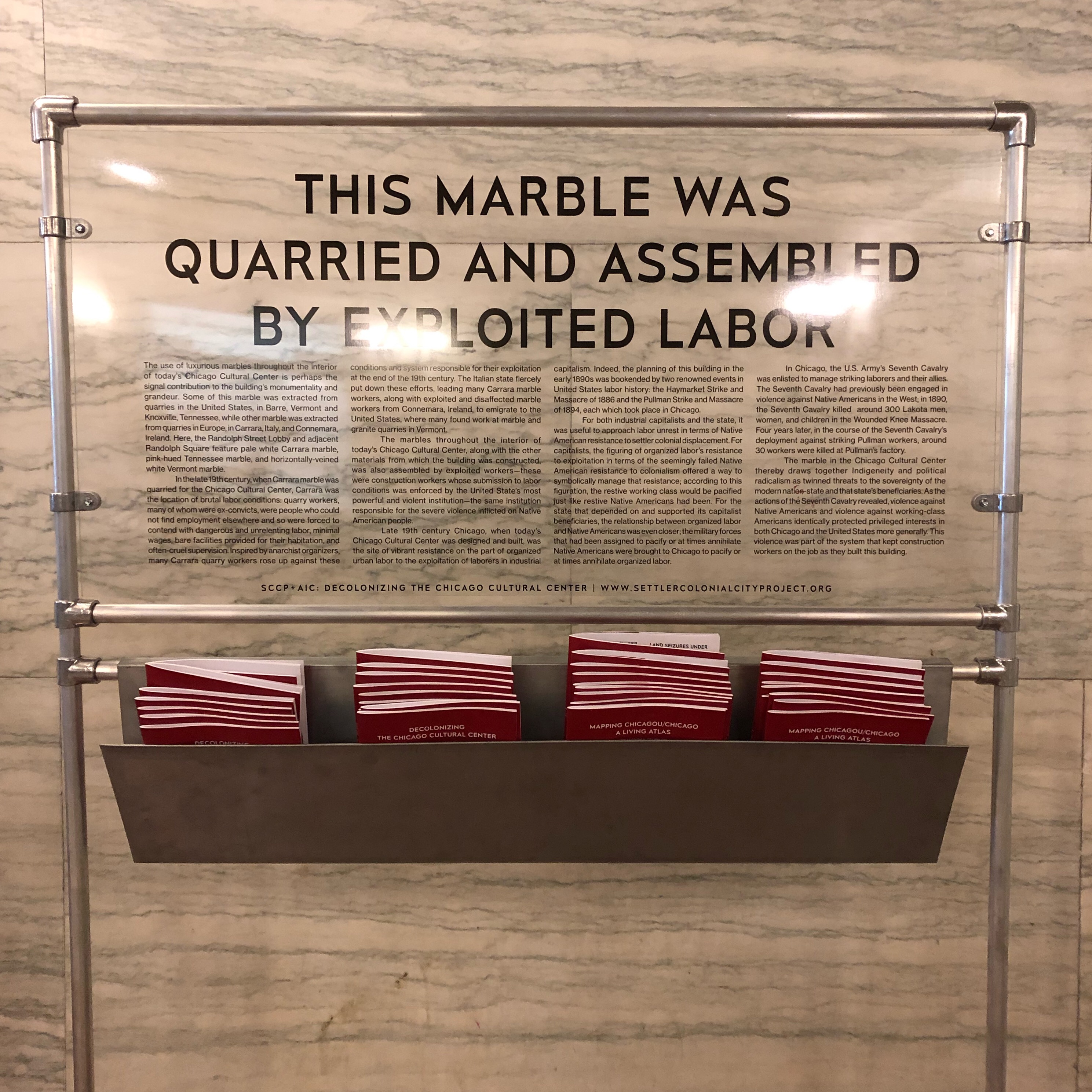Decolonizing Marble

THIS MARBLE WAS QUARRIED AND ASSEMBLED BY EXPLOITED LABOR
SCCP 2019
At Randolph St. Lobby, Chicago Cultural Center
The use of luxurious marbles throughout the interior of today's Chicago Cultural Center is perhaps the signal contribution to the building's monumentality and grandeur. Some of this marble was extracted from quarries in the United States, in Barre, Vermont and Knoxville, Tennessee, while other marble was extracted from quarries in Europe, in Carrara, Italy, and Connemara, Ireland. Here, the Randolph Street Lobby and adjacent Randolph Square feature pale white Carrara marble, pink-hued Tennessee marble, and horizontally-veined white Vermont marble.
In the late 19th century, when Carrara marble was quarried for the Chicago Cultural Center, Carrara was the location of brutal labor conditions: quarry workers, many of whom were ex-convicts, were people who could not find employment elsewhere and so were forced to contend with dangerous and unrelenting labor, minimal wages, bare facilities provided for their habitation, and often-cruel supervision. Inspired by anarchist organizers, many Carrara quarry workers rose up against these conditions and system responsible for their exploitation at the end of the 19th century. The Italian state fiercely put down these efforts, leading many Carrara marble workers, along with exploited and disaffected marble workers from Connemara, Ireland, to emigrate to the United States, where many found work at marble and granite quarries in Vermont.
The marbles throughout the interior of today's Chicago Cultural Center, along with the other materials from which the building was constructed, was also assembled by exploited workers--these were construction workers whose submission to labor conditions was enforced by the United State’s most powerful and violent institution--the same institution responsible for the severe violence inflicted on Native American people.
Late 19th century Chicago, when today’s Chicago Cultural Center was designed and built, was the site of vibrant resistance on the part of organized urban labor to the exploitation of laborers in industrial capitalism. Indeed, the planning of this building in the early 1890s was bookended by two renowned events in United States labor history: the Haymarket Strike and Massacre of 1886 and the Pullman Strike and Massacre of 1894, each which took place in Chicago.
For both industrial capitalists and the state, it was useful to approach labor unrest in terms of Native American resistance to settler colonial displacement. For capitalists, the figuring of organized labor’s resistance to exploitation in terms of the seemingly failed Native American resistance to colonialism offered a way to symbolically manage that resistance; according to this figuration, the restive working class would be pacified just like restive Native Americans had been. For the state that depended on and supported its capitalist beneficiaries, the relationship between organized labor and Native Americans was even closer; the military forces that had been assigned to pacify or at times annihilate Native Americans were brought to Chicago to pacify or at times annihilate organized labor.
In Chicago, the U.S. Army’s Seventh Cavalry was enlisted to manage striking laborers and their allies. The Seventh Cavalry had previously been engaged in violence against Native Americans in the West; in 1890, the Seventh Cavalry killed around 300 Lakota men, women, and children in the Wounded Knee Massacre. Four years later, in the course of the Seventh Cavalry’s deployment against striking Pullman workers, around 30 workers were killed at Pullman’s factory.
The marble in the Chicago Cultural Center thereby draws together Indigeneity and political radicalism as twinned threats to the sovereignty of the modern nation-state and that state’s beneficiaries. As the actions of the Seventh Cavalry revealed, violence against Native Americans and violence against working-class Americans identically protected privileged interests in both Chicago and the United States more generally. This violence was part of the system that kept construction workers on the job as they built this building.
